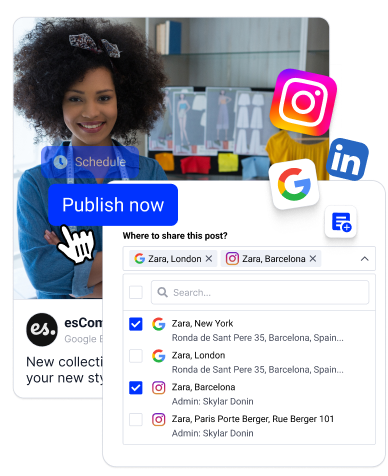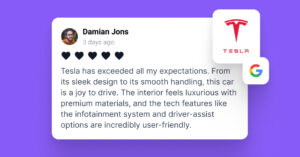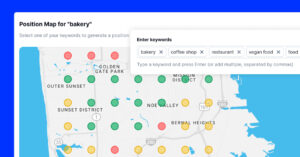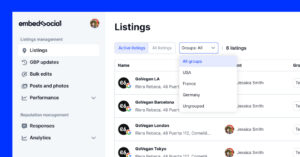Suivi Référencement local De nos jours, les mesures sont essentielles pour les entreprises nouvelles et naissantes, car elles fournissent des informations sur les performances du site web et guident les stratégies de croissance de votre marque.
En surveillant régulièrement vos principaux indicateurs de référencement, vous pouvez prendre des décisions fondées sur des données qui vous aideront à optimiser votre présence en ligne et à augmenter vos bénéfices.
Toutefois, si certains indicateurs sont indispensables à vérifier régulièrement, d'autres restent très utiles et il convient d'y jeter un coup d'œil de temps à autre.
Cela dit, je vous présente ci-dessous les indicateurs les plus importants pour le référencement que vous devriez examiner dès maintenant si vous ne voulez pas être distancé par vos concurrents !
Que signifie l'expression "indicateurs de référencement" ?
En bref, mesures d'optimisation des moteurs de recherche sont des points de données utilisés pour mesurer la performance d'un site web dans les moteurs de recherche, et en tant que tels, ils aident à évaluer l'efficacité des stratégies de référencement que vous avez mises en œuvre.
Définition de 'SEO Metrics
Bien que toutes les mesures de référencement fournissent des informations sur la visibilité de votre site web et l'engagement des utilisateurs, toutes n'informent pas sur vos stratégies.
Le plus important est d'examiner le trafic de recherche organique, le classement des mots clés, les liens retour et les taux de clics. Chacun de ces éléments met en évidence un domaine important du référencement.
Poursuivez votre lecture, car nous couvrons la plupart des paramètres ci-dessous :
Pourquoi faut-il suivre régulièrement les indicateurs de référencement ?
Le suivi régulier des indicateurs de référencement est vital pour votre entreprise, et ce pour plusieurs raisons :
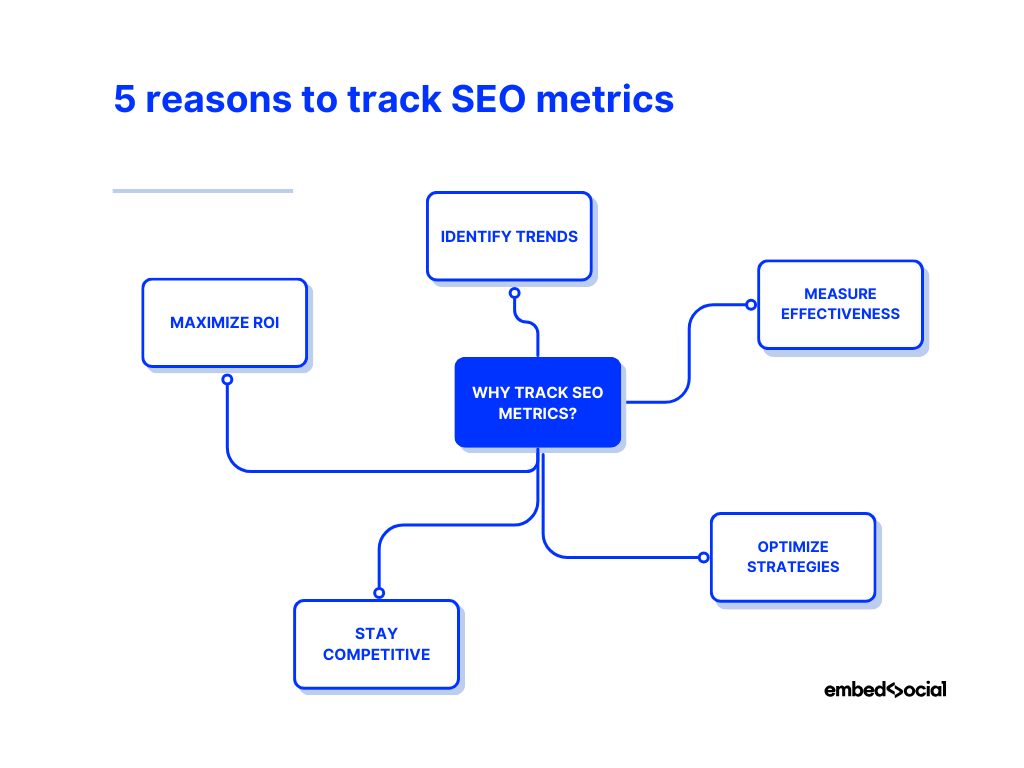
- Identifier les tendances-Le suivi régulier vous aide à repérer les tendances dans les performances de votre site web, ce qui vous permet d'ajuster vos stratégies de référencement en temps voulu ;
- Mesurer l'efficacité-Il vous permet de mesurer l'efficacité de vos efforts en matière de référencement, ce qui garantit que vos tactiques donnent les résultats escomptés ;
- Optimiser les stratégies-En surveillant les mesures, vous pouvez identifier les domaines nécessitant une amélioration, ce qui conduit à une optimisation continue de vos stratégies de référencement ;
- Rester compétitif-Le suivi régulier vous permet de connaître les performances de vos concurrents, ce qui vous aide à rester compétitif dans votre secteur d'activité ;
- Maximiser le retour sur investissement-Enfin, le suivi des mesures permet de s'assurer que vos ressources sont utilisées de manière efficace afin de maximiser votre retour sur investissement (ROI).
Comme vous pouvez le constater, un suivi régulier du référencement est essentiel pour maintenir et améliorer les performances de votre site web afin que vous puissiez devancer vos concurrents. Après tout, c'est en gagnant la bataille du marketing en ligne que vous gagnerez et conserverez des clients à l'ère numérique actuelle.
Une fois que vous maîtrisez ces paramètres, vous pouvez passer à des méthodes plus avancées pour améliorer votre visibilité en matière de référencement local, telles que la mise en place d'un système d'information sur l'environnement. Classement par étoiles agrégé par Google!
Mesures de référencement de base à suivre régulièrement
Lorsque vous cherchez des indicateurs de référencement à suivre, vous devriez toujours commencer par les éléments suivants :
1. Trafic organique
Qu'est-ce que c'est et pourquoi c'est important ?
Le trafic organique désigne les visiteurs qui trouvent votre site web grâce aux résultats des moteurs de recherche. Il mesure l'efficacité de vos efforts de référencement et votre visibilité globale.
Utile pour :
Suivi de la visibilité globale du site web et mesure de l'impact des campagnes de référencement.
Comment le suivre et des conseils pour l'améliorer :
Utilisez des outils tels que Google Analytics. Améliorez-la en optimisant le contenu avec des mots-clés pertinents et en améliorant la structure du site.
2. Classement des mots-clés
Qu'est-ce que c'est et pourquoi c'est important ?
Le classement par mot-clé indique dans quelle mesure votre site est classé pour des mots-clés spécifiques dans les moteurs de recherche. Un classement élevé est le signe d'une bonne performance en matière de référencement.
Utile pour :
Identifier les mots-clés les plus performants et évaluer l'efficacité de la stratégie de référencement.
Comment le suivre et des conseils pour l'améliorer :
Effectuez un suivi à l'aide d'outils tels que Ahrefs ou SEMrush. Améliorez votre classement en ciblant des mots-clés pertinents et en actualisant votre contenu.
3. Les backlinks
Qu'est-ce que c'est et pourquoi c'est important ?
Les backlinks sont des liens de domaines référents vers votre site. Ils jouent un rôle crucial dans le référencement, en renforçant la crédibilité et l'autorité.
Utile pour :
Renforcer l'autorité du domaine et améliorer le classement dans les moteurs de recherche.
Comment le suivre et des conseils pour l'améliorer :
Utilisez des outils comme Ahrefs et Moz pour l'analyse. Améliorez la situation en acquérant des liens retour de haute qualité par le biais de la sensibilisation et de la collaboration en matière de contenu avec les domaines de référence.
4. Taux de clics (CTR)
Qu'est-ce que c'est et pourquoi c'est important ?
Le CTR est le rapport entre le nombre d'utilisateurs qui cliquent sur votre lien et le nombre d'utilisateurs qui le voient. Il indique l'efficacité de vos méta-descriptions et de vos titres.
Utile pour :
Évaluer l'attrait de vos extraits de recherche et améliorer le trafic.
Comment le suivre et des conseils pour l'améliorer :
Contrôler avec Google Search Console. Améliorez vos résultats en rédigeant des méta-descriptions et des titres convaincants.
5. Taux de rebond
Qu'est-ce que c'est et pourquoi c'est important ?
Le taux de rebond est le pourcentage de visiteurs qui quittent votre site après avoir consulté une seule page. Il reflète l'engagement des utilisateurs et la qualité du site.
Utile pour :
Évaluer l'expérience des utilisateurs et identifier les domaines à améliorer.
Comment le suivre et des conseils pour l'améliorer :
Suivi avec Google Analytics. Réduire le taux de rebond en améliorant le contenu du site et la navigation.
6. Taux de conversion
Qu'est-ce que c'est et pourquoi c'est important ?
Le taux de conversion est le pourcentage de visiteurs qui accomplissent une action souhaitée. Il mesure l'efficacité de votre site à susciter des actions.
Utile pour :
Évaluer le succès de vos efforts de marketing et la fonctionnalité de votre site web.
Comment le suivre et des conseils pour l'améliorer :
Utilisez des outils tels que Google Analytics. Améliorer en optimisant les pages d'atterrissage et les appels à l'action.
Mesures avancées de référencement pour les entreprises
En plus de ce qui précède, les entreprises devraient prendre en compte d'autres paramètres avancés :
7. Autorité du domaine (DA) et autorité de la page (PA)
Qu'est-ce que c'est et pourquoi c'est important ?
L'autorité du domaine (DA) et l'autorité de la page (PA) sont des mesures développées par Moz qui permettent de prédire le classement d'un site web ou d'une page dans les résultats des moteurs de recherche. Des scores plus élevés indiquent un meilleur potentiel de classement.
Utile pour :
Évaluer la force globale d'un site web et de ses pages individuelles. Comparer l'autorité de votre site à celle de vos concurrents.
Comment le suivre et des conseils pour l'améliorer :
Utilisez Link Explorer de Moz ou Vérificateur de DA/DR par Editorial.Link pour mesurer le DA et le PA. Améliorez ces mesures en acquérant des backlinks de haute qualité et en créant du contenu de valeur.
8. Erreurs d'exploration
Qu'est-ce que c'est et pourquoi c'est important ?
Les erreurs de crawl se produisent lorsqu'un moteur de recherche tente d'atteindre une page de votre site mais n'y parvient pas. Ces erreurs peuvent empêcher les pages d'être indexées correctement.
Utile pour :
Identifier les problèmes qui entravent l'indexation par les moteurs de recherche. S'assurer que toutes les pages importantes sont accessibles aux moteurs de recherche.
Comment le suivre et des conseils pour l'améliorer :
Surveillez les erreurs d'exploration à l'aide de Google Search Console. Corrigez les erreurs en mettant à jour ou en redirigeant les liens brisés et en veillant à ce que le sitemap soit propre.
9. Utilisabilité mobile
Qu'est-ce que c'est et pourquoi c'est important ?
L'utilisabilité mobile fait référence à l'efficacité de votre site web sur les appareils mobiles. Une bonne utilisabilité mobile est cruciale car de plus en plus d'utilisateurs accèdent au web via des appareils mobiles.
Utile pour :
Amélioration de l'expérience utilisateur pour les visiteurs mobiles. Améliorer le classement dans les moteurs de recherche mobiles.
Comment le suivre et des conseils pour l'améliorer :
Utilisez le test de convivialité mobile de Google et le rapport sur la convivialité mobile dans Google Search Console. Améliorez votre site en adoptant une conception réactive et en optimisant la vitesse de chargement des pages pour les appareils mobiles.
Visibilité SEO métriques de recherche
Pour les entreprises qui souhaitent améliorer leurs performances globales en matière de recherche, il est essentiel de se concentrer sur la visibilité et les impressions :
10. Visibilité SEO
Qu'est-ce que c'est et pourquoi c'est important ?
La visibilité SEO mesure la fréquence à laquelle votre site apparaît dans les résultats des moteurs de recherche. Il s'agit d'un indicateur qui reflète la présence globale de votre site sur les moteurs de recherche.
Utile pour :
Évaluer l'impact des stratégies de référencement. Comprendre la portée et la présence de votre site dans les résultats de recherche.
Comment le suivre et des conseils pour l'améliorer :
Contrôlez la visibilité du référencement avec des outils tels que SEMrush ou Ahrefs. Améliorez-la en optimisant le contenu, en ciblant des mots-clés pertinents et en créant des liens retour de haute qualité.
11. Impressions de recherche
Qu'est-ce que c'est et pourquoi c'est important ?
Les impressions de recherche sont le nombre de fois où votre site apparaît dans les résultats de recherche. Des impressions plus importantes indiquent une meilleure visibilité dans les moteurs de recherche.
Utile pour :
Mesurer la portée de votre site web. Identifier le potentiel d'augmentation du trafic.
Comment le suivre et des conseils pour l'améliorer :
Suivez les impressions avec Google Search Console. Augmentez le nombre d'impressions en optimisant les mots-clés pertinents et en améliorant le contenu du site.
Mesures hebdomadaires supplémentaires de référencement à mesurer
Enfin, il existe d'autres indicateurs de référencement que vous devez suivre chaque semaine.
Suivi des tendances du trafic organique vous aide à comprendre les fluctuations du nombre de visiteurs qui trouvent votre site par le biais des moteurs de recherche. Cette information est essentielle pour évaluer l'efficacité de vos stratégies de référencement en cours et pour identifier les tendances du trafic. Vous pouvez utiliser vos données Google Analytics pour suivre ces tendances.
Fluctuations du classement des mots clés sont un autre indicateur important, qui montre les changements dans la position de votre site pour des mots-clés spécifiques au fil du temps. Cela indique dans quelle mesure vos stratégies de mots-clés sont performantes. En surveillant ces classements à l'aide d'outils tels que SEMrush ou Ahrefs, vous pouvez identifier les mots-clés qui gagnent ou perdent du terrain et ajuster vos efforts en conséquence.
Croissance des backlinks suit l'augmentation des liens d'autres sites web vers le vôtre, ce qui joue un rôle clé dans l'amélioration de l'autorité du domaine et du classement dans les moteurs de recherche. Si vous gérez un site web ou si vous travaillez avec un Agence de création de liens SaaSIl est donc essentiel d'évaluer régulièrement votre profil de liens retour à l'aide d'outils tels que Ahrefs ou Moz. Renforcez votre stratégie de création de liens en créant un contenu de grande valeur et en investissant dans des efforts de sensibilisation intelligents pour obtenir des liens de qualité.
Mesures de référencement sur la pageLes éléments de référencement, tels que les balises de titre, les méta-descriptions, les balises d'en-tête et la qualité du contenu, sont essentiels à l'optimisation des pages individuelles pour les moteurs de recherche. La mise à jour régulière de ces éléments sur la base des meilleures pratiques de référencement améliore l'expérience de l'utilisateur et le classement dans les moteurs de recherche. Des outils tels que Yoast SEO peuvent aider à analyser et à améliorer le référencement de chaque page.
En savoir plus sur la façon dont Les avis de Google ont un impact sur votre référencement en 2024 !
Quelle est la mesure la plus cruciale pour le référencement local : L'avis de 15 experts en référencement
Vous vous demandez ce que les experts ont à dire sur ce qui est le plus important ? référencement local que vous devez suivre ? Voici les opinions de 15 leaders du secteur :
- Part de valeur de la métrique vocale locale
- Suivi de l'engagement dans Google My Business
- Surveiller les classements locaux
- Classement dans le pack local : Un indicateur clé
- Améliorer le classement du profil d'entreprise dans Google
- Leads générés par semaine
- Impact sur le classement des mots clés locaux
- Visibilité dans les moteurs de recherche locaux via GMB
- Dépouillement et analyse du contenu
- Correspondance de mots-clés pour les produits de niche
- Moyenne du classement dans Google Maps
- Nombre de visites mensuelles sur Google My Business
- Suivi et analyse détaillés des appels
- Se concentrer sur le coût par conversion
- Trafic organique vers les pages d'atterrissage
Pour un résumé et une explication, n'hésitez pas à vous référer à ce tableau :
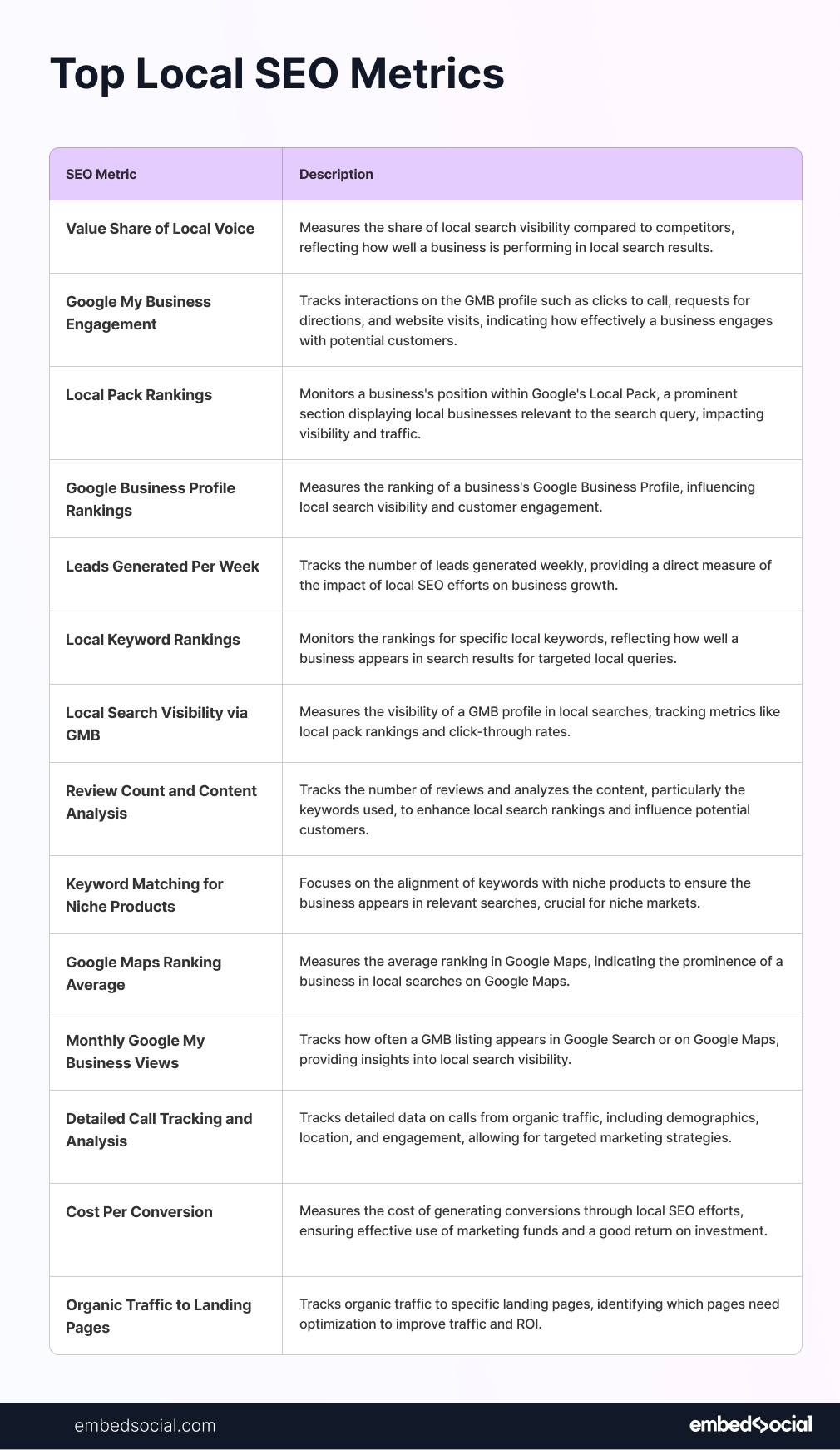
1. Part de valeur de la métrique vocale locale
Les utilisateurs qui effectuent des recherches locales ont une forte intention d'acheter ou de visiter une entreprise. Cependant, l'attribution est souvent difficile, c'est pourquoi je pense que les mesures de référencement local sont mieux alignées sur la visibilité, et c'est pour cette raison que nous aimons la part de voix locale (Share of Local Voice - SoLV). Les clients apprécient toujours cette mesure, en particulier lorsqu'ils comparent les résultats à ceux de leurs concurrents directs.
Quentin Aisbett, stratège SEO & SEM, Recherche
2. Suivi de l'engagement dans Google My Business
Le taux d'engagement de Google My Business (GMB), qui comprend les appels téléphoniques, les demandes d'itinéraire et les visites de sites web à partir du profil GMB, est probablement l'indicateur de référencement local le plus important que je suive. Le suivi de ces données me permet de savoir comment une entreprise s'engage avec les clients potentiels qui la trouvent dans les résultats de recherche locaux.
Par exemple, avec l'un de nos clients restaurateurs sur le marché local, nous avons constaté que, bien que le profil GMB reçoive de nombreuses vues, il y avait relativement peu d'actions. Nous avons commencé à optimiser le profil GMB en y ajoutant des photos, en décrivant la plupart des services/caractéristiques et en le publiant régulièrement.
Il a ensuite constaté une augmentation considérable de l'engagement, ce qui a clairement conduit à une augmentation de la fréquentation et à un pic certain des réservations, en corrélation avec des augmentations directes de leurs revenus. Il a été formidable de pouvoir mesurer et améliorer l'engagement sur GMB afin de montrer à nos clients la valeur réelle de notre travail en matière de référencement local.
Andrii LatenkoExpert SEO & LinkBuilder, Liens HARO Agence de référencement
3. Surveiller les classements locaux
Je pense que la mesure de référencement local la plus importante à suivre est le classement local. Cette mesure est cruciale car elle a un impact direct sur la visibilité d'une entreprise dans les résultats de recherche locaux de Google, ce qui peut influencer de manière significative le trafic et les conversions.
Classement local font référence à la position d'une entreprise dans le Google Local Pack (également connu sous le nom de Map Pack ou 3-Pack), qui apparaît en haut des résultats de recherche pour les requêtes ayant une intention locale. Cette position privilégiée est extrêmement précieuse pour les entreprises locales, car c'est souvent la première chose que les utilisateurs voient lorsqu'ils recherchent des produits ou des services locaux.
Voici un exemple de la façon dont le suivi et l'amélioration des classements locaux ont profité à l'un de mes clients :
J'ai travaillé avec un petit restaurant italien familial situé dans une zone urbaine compétitive. Au départ, il n'apparaissait pas dans le Local Pack pour des recherches pertinentes telles que "restaurant italien près de chez moi" ou "meilleures pâtes à [nom de la ville]".
Nous avons mis en œuvre une stratégie complète de référencement local, en nous concentrant sur l'optimisation de leur Profil d'entreprise Googleaméliorer la pertinence locale de leur site web et encourager les commentaires des clients.
Pendant six mois, nous avons suivi leur classement local à l'aide d'outils tels que LocalFalcon, qui permet un suivi granulaire des classements dans les différentes localités d'une même ville. Nous avons constaté une amélioration constante, et finalement, le restaurant a commencé à apparaître dans le Local Pack pour ses mots-clés cibles.
L'impact a été important :
- Visibilité accrue : Le restaurant apparaît désormais en bonne place dans les recherches locales, ce qui l'expose à un public beaucoup plus large.
- Augmentation du trafic sur le site web : Les taux de clics depuis le Local Pack vers leur site web ont augmenté de 150% par rapport à leurs précédentes listes de recherche organique.
- Augmentation de la fréquentation : Le restaurant a enregistré une augmentation de 30% du nombre de clients qui ont déclaré l'avoir trouvé grâce à des recherches sur Google.
- Amélioration du taux de conversion : Les appels téléphoniques et les réservations en ligne ont augmenté de 40%, ce qui est directement imputable à l'amélioration de la présence de Local Pack.
- Croissance du chiffre d'affaires : Le chiffre d'affaires global a augmenté de 25% au cours des six mois qui ont suivi leur apparition régulière dans le Local Pack.
Cet exemple démontre la puissance du suivi et de l'amélioration des classements locaux. Il ne s'agit pas seulement de visibilité, cela se traduit directement par des résultats commerciaux tangibles. En nous concentrant sur cette mesure, nous avons pu améliorer de manière significative la présence en ligne du restaurant et, plus important encore, ses résultats.
Sara BorghiConsultant SEO et stratège SEO senior chez Oncrawl, Sara Borghi
4. Classement dans le pack local : Un indicateur clé
Pour notre agence, l'une des mesures de référencement local les plus importantes que nous suivons est le classement "Local Pack" ou "Map Pack". Il s'agit d'une section importante des résultats de recherche de Google qui affiche une carte ainsi qu'une liste de trois entreprises locales correspondant à la requête de recherche. Le fait d'apparaître dans ce "Local Pack" augmente considérablement la visibilité et le trafic d'une entreprise, ce qui en fait un indicateur clé pour mesurer le succès du référencement local.
Les facteurs qui influencent le classement dans le Local Pack comprennent l'optimisation de Google My Business (GMB), les citations locales, les avis, ainsi que la pertinence et la proximité de l'entreprise par rapport à l'endroit où se trouve le chercheur. Le suivi et l'amélioration du classement dans le Local Pack peuvent grandement améliorer la présence d'une entreprise dans les moteurs de recherche locaux et ses efforts d'acquisition de clients.
Melysha Acharya, SEO, Un référencement vraiment abordable
5. Améliorer le classement du profil d'entreprise dans Google
L'une des mesures les plus importantes que je suis en matière de référencement local est la Classement de Google Business Profile (GBP). Cette mesure est cruciale car elle influence directement la visibilité dans les moteurs de recherche locaux et l'engagement des clients. Par exemple, j'ai travaillé avec une boulangerie locale située dans une zone touristique en Grèce, qui avait du mal à attirer le trafic malgré d'excellentes critiques. En nous concentrant sur l'amélioration de son classement GBP, nous avons réussi à accroître sa visibilité dans les recherches locales, c'est-à-dire auprès des personnes qui recherchent ses produits lorsqu'elles sont en visite ou de passage dans la région.
Pour ce faire, nous avons optimisé leur profil en y ajoutant des informations commerciales précises, des images de haute qualité et des publications régulières. En outre, nous avons encouragé les clients satisfaits à laisser des messages sur leur site. à l'aide d'un moteur de recherche Google La plaque d'évaluation a été munie d'un code QR en magasin, ce qui a considérablement renforcé la crédibilité de leur profil. En conséquence, leur classement s'est considérablement amélioré pour atteindre l'une des trois premières positions pour les principaux termes de recherche locaux. Cette augmentation de la visibilité a entraîné une hausse de 40% du trafic piétonnier et une augmentation notable des ventes.
Cet exemple montre à quel point le classement dans les GBP est essentiel pour les entreprises locales. En surveillant et en optimisant constamment cette mesure, les entreprises peuvent améliorer leur présence locale et attirer davantage de clients.
George PapatheodorouConsultant en marketing numérique, George Papatheodorou
6. Leads générés par semaine
Leads générés par semaine. En fin de compte, les chefs d'entreprise ne cherchent pas seulement à être mieux classés dans les résultats de recherche ; ils veulent créer des résultats réels et tangibles pour leur entreprise. Il existe de nombreux points de contact entre un meilleur classement et une vente, et le parcours de l'acheteur n'est pas toujours linéaire, mais le suivi des prospects par semaine est un bon moyen de vérifier la santé de votre référencement.
Amanda HamiltonSpécialiste des sites web et du référencement, Anchor 'A' Digital Design Co.
7. Impact sur le classement des mots-clés locaux
L'une des mesures essentielles du référencement local que nous suivons est le classement des mots-clés locaux, c'est-à-dire la manière dont votre entreprise se classe pour les termes de recherche pertinents dans votre région.
Par exemple, pour notre entreprise de nettoyage, nous nous sommes concentrés sur l'optimisation de termes tels que "meilleur nettoyage de bureaux à [ville]" et "nettoyage de maison abordable près de chez moi". En créant du contenu localisé et en s'inscrivant sur les listes de annuaires locauxNous avons constaté que le classement des mots clés s'améliorait considérablement. Cela a conduit à une augmentation de 40% du trafic organique et à une augmentation notable des demandes et des réservations, en corrélation directe avec une meilleure visibilité pour les recherches locales ciblées.
Zeeshan SiddiquiFondateur, SEO pour les services de nettoyage
8. Visibilité dans les moteurs de recherche locaux via GMB
La mesure de référencement local la plus importante que je suis est la visibilité du profil Google My Business (GMB) dans les recherches locales, en particulier le suivi de mesures telles que les classements dans le pack local et les taux de clics (CTR). Par exemple, en optimisant le profil GMB d'un client et en surveillant ces mesures, nous avons identifié une augmentation significative des apparitions dans le classement local et du CTR, ce qui a conduit à une augmentation de 30% du trafic piétonnier et à une augmentation de 20% des ventes locales sur une période de trois mois.
Evgen KushnirchukMarketer, expert en référencement et PDG de HireDevelopers.biz
9. Dépouillement et analyse du contenu
La mesure de référencement local la plus importante que nous suivons chez SmartSites est le nombre d'avis et le contenu des avis, en particulier les mots-clés utilisés dans ces avis. Les avis n'influencent pas seulement les clients potentiels, mais jouent également un rôle crucial dans le classement des recherches locales.
Par exemple, nous avons travaillé avec une entreprise locale de chauffage, de ventilation et de climatisation pour améliorer son référencement local. En encourageant les clients satisfaits à laisser des commentaires détaillés mentionnant des services et des mots clés spécifiques, tels que "réparation de climatisation" et "installation de chauffage", nous avons considérablement augmenté leur visibilité sur les moteurs de recherche. Les résultats ont démontré l'impact puissant que peut avoir le fait de se concentrer sur les indicateurs d'évaluation pour améliorer le classement dans les moteurs de recherche locaux et stimuler la croissance de l'entreprise.
Michael MelenCo-fondateur, SmartSites
10. Correspondance des mots-clés pour les produits de niche
Le référencement est un élément important du plan de marketing de toute entreprise, en particulier si vous avez une activité de commerce électronique. Sans un référencement efficace, vous courez le risque que votre marque ou votre produit ne soit jamais découvert par le consommateur qui le recherche. La correspondance avec des mots-clés spécifiques est l'une des mesures de référencement les plus importantes à suivre.
Pour nous, les mots-clés sont la mesure de référencement la plus solide en raison de la nature de notre activité. Lorsque votre produit principal est plus spécialisé, vous devez utiliser la bonne combinaison de mots-clés. Il doit s'agir de mots que les consommateurs utilisent couramment lorsqu'ils recherchent ce type de produit spécifique. Si vous ne réfléchissez pas attentivement à la planification de vos mots-clés, vos clients potentiels risquent de vous passer sous le nez et de se rendre sur le site d'un concurrent.
Il est également important de comprendre que le référencement évolue. Il s'agit davantage d'un concept fluide que d'une règle fixe. Une chose que j'ai trouvée fructueuse est de me tourner vers les médias sociaux pour rechercher des mots-clés en vogue. Des plateformes comme TikTok ont permis de faire grimper en flèche les ventes de toutes sortes de marques et de produits, c'est pourquoi il est utile de rechercher ce qui est tendance. Trouver ces mots tendance et les incorporer dans notre référencement a été une stratégie de marketing efficace pour nous.
Olivar BrandrupDirecteur de l'optimisation des ressources, Neurogan
11. Moyenne du classement Google Maps
En tant que fondateur d'une société de référencement local, je sais qu'il n'y a pas de deuxième mesure proche de la moyenne de classement d'une entreprise locale sur Google Maps. Environ 90% des personnes qui recherchent des entreprises locales utilisent Google pour les trouver, et environ 50% d'entre elles cliquent sur l'un des trois premiers classements de Google Maps. La différence entre #10 et #1 représente bien plus de 10 fois le nombre d'appels, de clics ou de visites de magasins que vous obtiendrez en un mois.
Les entreprises peuvent dès aujourd'hui contrôler quelques indicateurs clés d'un bon classement sur Google Maps : publier au moins un article utile et d'actualité par semaine sur votre profil Google Business et obtenir au moins un avis de client par semaine. Il y a bien d'autres choses à faire, mais si vous commencez par ces deux éléments, vous aurez une longueur d'avance sur 90% des listes de Google Maps. En vous concentrant sur les indicateurs avancés plutôt que sur l'indicateur retardé du classement, vous pouvez rester motivé et finir par atteindre votre objectif final, à savoir un classement local élevé sur Google.
Elliott KosmickiFondateur et président, Impact majeur
12. Nombre de vues mensuelles sur Google My Business
La mesure la plus importante pour le référencement local est le nombre de vues mensuelles sur Google My Business (GMB), qui indique combien de fois votre fiche est apparue dans une recherche Google ou sur Google Maps. Ces données sont disponibles dans GMB Insights et peuvent être intégrées dans un tableau de bord Looker Studio.
Notre agence est spécialisée dans le référencement local pour les marques à magasins multiples. L'utilisation de tableaux de bord permettant de suivre le nombre de vues GMB de chaque magasin nous permet de voir quels sont les sites qui fonctionnent bien et ceux qui ont besoin d'attention. Nous pouvons également suivre la croissance du nombre de vues GMB au fil du temps et montrer les résultats de notre travail.
En résumé : Les vues GMB sont au référencement local ce que les visites de sites web sont au référencement standard. Vous les suivez pour voir si vous vous développez.
Je suis toujours surpris de constater que peu de référenceurs connaissent cette mesure ou savent comment la suivre pour plusieurs magasins.
Tom DahmPrésident, BridgePose Digital LLC
13. Suivi et analyse détaillés des appels
Nous aimons suivre les appels de manière très détaillée. Nous utilisons un numéro de suivi pour le trafic organique, ce que beaucoup de gens utilisent. Cependant, nous suivons également les clics vers ces numéros de suivi des appels dans Google Analytics, et nous marquons ces sessions comme "conversion" dans Microsoft Clarity. Cela nous permet de segmenter les personnes qui appellent, leurs données démographiques, leur localisation, l'heure de la journée, de suivre l'engagement sur le site web et même de visualiser l'ensemble de leur session de navigation.
Nous le faisons également pour d'autres conversions. Cependant, j'aime beaucoup ce type de suivi pour le local car vous pouvez commencer à utiliser les données du suivi des appels dans des choses telles que les annonces avec appels uniquement pour les "zones chaudes", les lieux physiques d'où vous recevez beaucoup d'appels ou les services qui déclenchent beaucoup d'appels téléphoniques.
Chris CastilloPropriétaire, Propel Digital Marketing
14. Se concentrer sur le coût par conversion
La statistique la plus cruciale semble être le coût par conversion (CPC). Les entreprises ne peuvent pas déterminer l'efficacité de leurs efforts de référencement local sans connaître le CPC. Cet indicateur garantit un retour sur investissement lucratif en matière de référencement local et une utilisation efficace des fonds de marketing. Si une campagne de référencement local ou une approche par mot-clé génère des conversions à un coût inférieur, vous pouvez investir plus d'argent dans cette campagne.
En revanche, un CPC élevé peut indiquer qu'il est nécessaire de changer de stratégie. Cela permet aux entreprises de ne sélectionner que des mots-clés de haute qualité tout en éliminant ou en modifiant les mots-clés inefficaces, en se concentrant sur les efforts de référencement local.
Billy ParkerPDG, fondateur, Livraison de cadeaux
15. Trafic organique vers les pages d'atterrissage
Notre agence de référencement suit notre trafic organique global et le trafic organique vers les pages d'atterrissage. Elle utilise ces informations pour déterminer les pages et les blogs dont le trafic diminue d'une année sur l'autre. À partir de là, ils déterminent un plan pour augmenter le trafic vers ces pages de destination, par exemple en ajoutant du contenu utile, en créant des liens vers ces pages ou en optimisant les mots-clés.
Notre trafic repart généralement à la hausse une fois que les problèmes de ces pages ont été résolus. C'est important pour nous de voir cela car cela nous montre que le travail qu'ils font augmente notre présence dans la recherche organique et encourage le retour sur investissement pour notre équipe.
Bill RudmanDirecteur, Le projet de théâtre musical
Outils de surveillance et de suivi du référencement
Le contrôle et le suivi des paramètres de référencement sont essentiels pour que les petites et moyennes entreprises (PME) restent compétitives. Les outils suivants offrent des informations précieuses et des fonctionnalités adaptées pour aider les PME à optimiser leurs stratégies de référencement de manière efficace.
1. Google Analytics
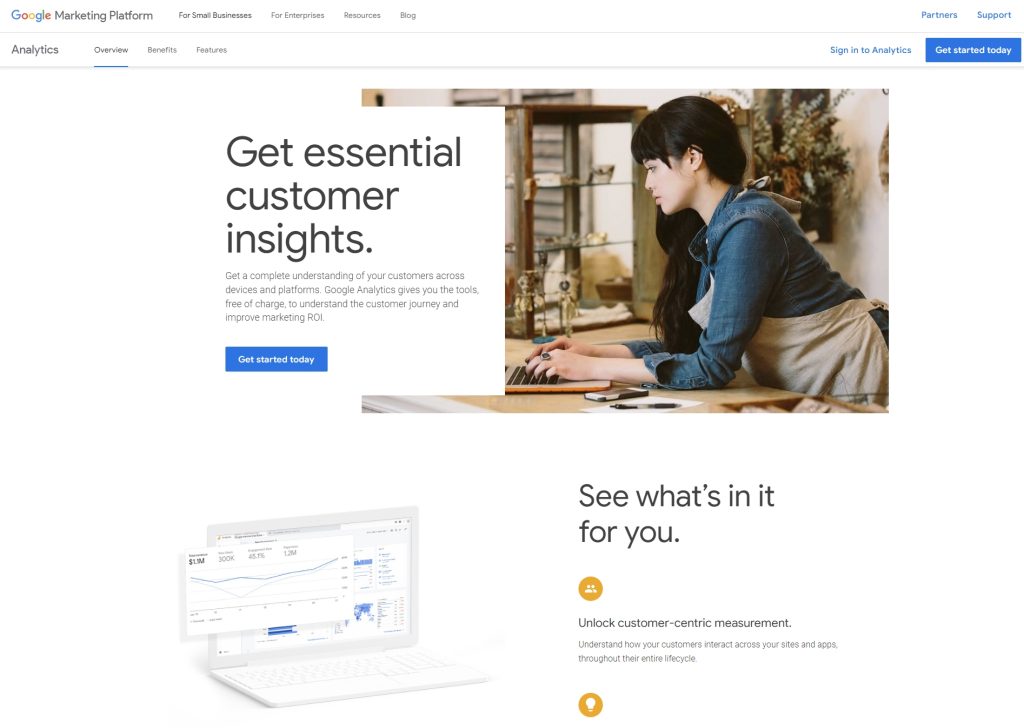
Google Analytics fournit des données complètes sur le trafic du site web et le comportement des utilisateurs. Elle aide les PME à comprendre quelles pages sont performantes, à suivre les objectifs de conversion et à identifier les sources de trafic. Ainsi, les rapports détaillés et les données en temps réel de la plateforme permettent aux entreprises de prendre des décisions éclairées et d'optimiser leur présence en ligne.
Un L'une des principales caractéristiques de Google Analytics est sa capacité à segmenter les publicsqui vous permet de mieux comprendre vos clients. L'analyse des différents segments d'utilisateurs vous permet d'adapter vos stratégies pour cibler plus efficacement des groupes spécifiques.
Google Analytics s'intègre à d'autres produits GoogleLes services d'aide à la décision, tels que les annonces, vous permettent de suivre les performances de vos campagnes publicitaires et de les ajuster si nécessaire.
Enfin, les tableaux de bord et les rapports personnalisables de la plateforme permettent de suivre les indicateurs clés en un coup d'œil et d'accéder à toutes les fonctionnalités de la plateforme en un seul clic.
Prix : Il est gratuit pour une utilisation standard, et une version premium pour les entreprises (Google Analytics 360) est disponible sur demande.
2. Ahrefs
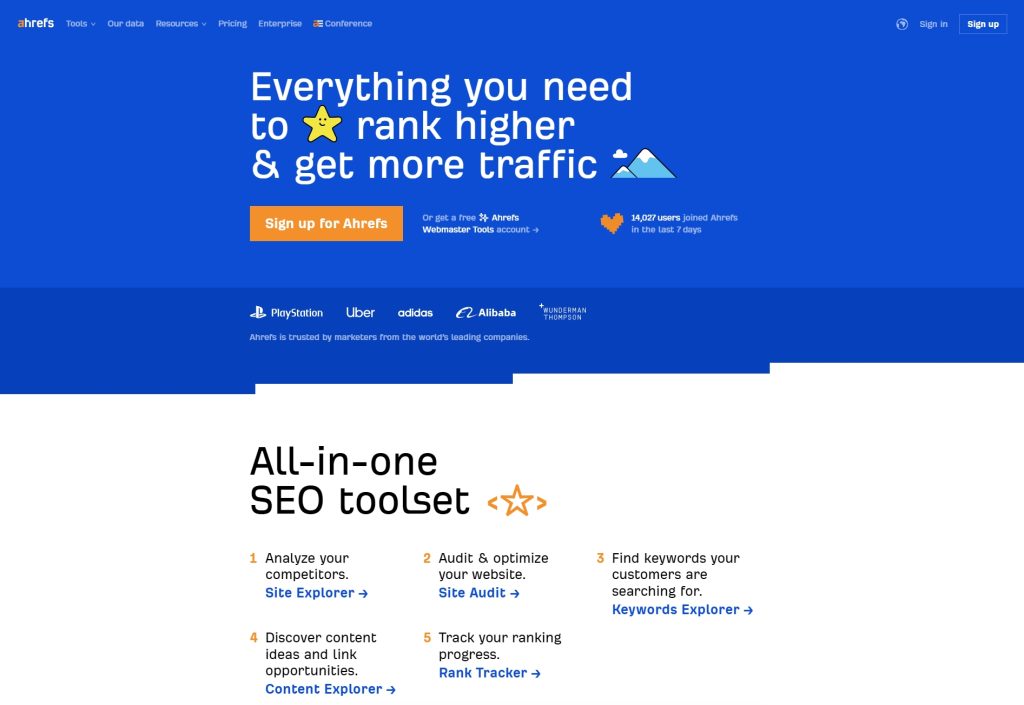
Ahrefs est connue pour ses analyse robuste des liens retour (backlink) et des fonctions de recherche de mots-clés. Les PME peuvent bénéficier de son outil d'audit de site, qui identifie les problèmes de référencement et suggère des améliorations. Vous bénéficiez également d'une analyse concurrentielle qui vous permet de suivre les performances de vos concurrents et de découvrir des opportunités de croissance à tout moment.
La plateforme Explorateur de contenu vous aide à découvrir les contenus les plus populaires dans votre secteur d'activité, ce qui vous permet de trouver l'inspiration et de savoir ce qui trouve un écho auprès de votre public. En comprenant les types de contenus qui fonctionnent bien, vous pouvez créer des contenus plus attrayants.
Ahrefs's Suivi des classements surveille le classement de vos mots clés au fil du temps et les compare à ceux de vos concurrents. Cette fonction est essentielle pour évaluer l'efficacité de vos stratégies de référencement et procéder aux ajustements nécessaires pour améliorer votre classement.
Prix : Le plan Lite, adapté aux petites entreprises, commence à $129 par mois, et le plan Advanced, à $449/mois ou $14,990/an, est destiné aux entreprises.
3. Semrush
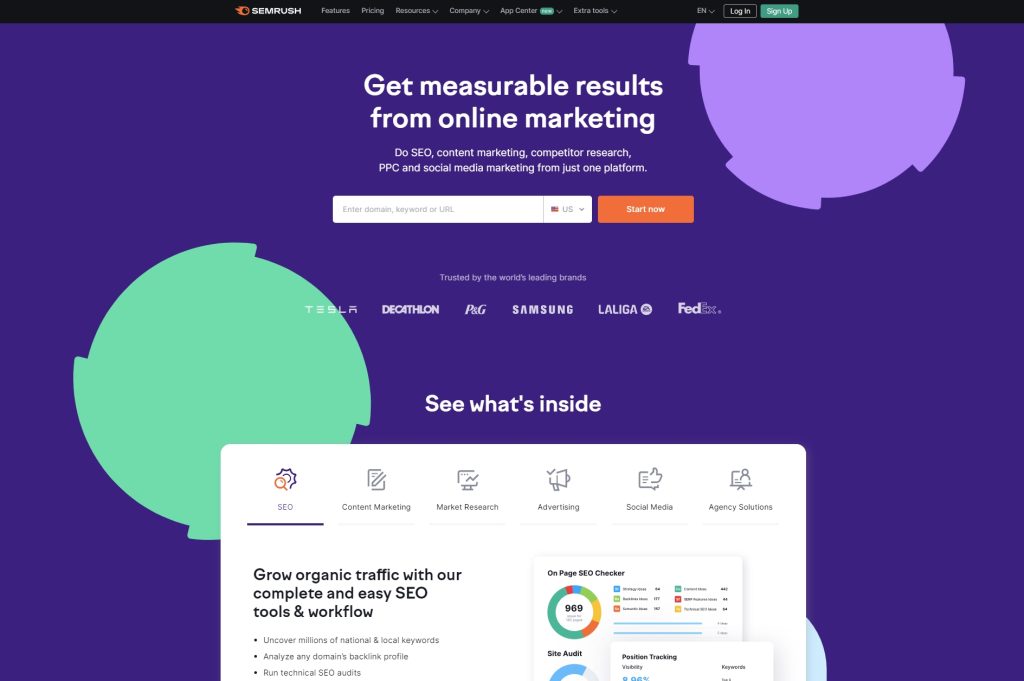
Comme Ahrefs, Semrush offre des outils pour recherche de mots-clés, audits de siteset l'analyse des concurrents. Son L'interface conviviale et les rapports détaillés de Semrush permettent aux PME de contrôler facilement leurs efforts de référencement. Le suivi de position et les informations sur le trafic organique de Semrush vous aideront à affiner vos stratégies et à améliorer votre classement dans les moteurs de recherche.
L'une des principales caractéristiques de Semrush est sa fonction 'Audit du site qui analyse les sites web à la recherche de problèmes techniques susceptibles d'affecter les performances en matière de référencement. En identifiant et en corrigeant ces problèmes, vous pouvez vous assurer que votre site est entièrement optimisé pour les moteurs de recherche.
La plateforme est également dotée d'un Outil de magie des mots-clésqui vous aide à trouver les meilleurs mots-clés à cibler pour vos campagnes de référencement. Cet outil fournit des données sur le volume de recherche, la difficulté des mots-clés et bien plus encore, ce qui vous permet de choisir des mots-clés efficaces.
Prix : Le plan Pro, idéal pour les freelances et les startups, commence à $139,95 par mois et peut être étendu à $499 par mois pour le plan Business.
4. Moz
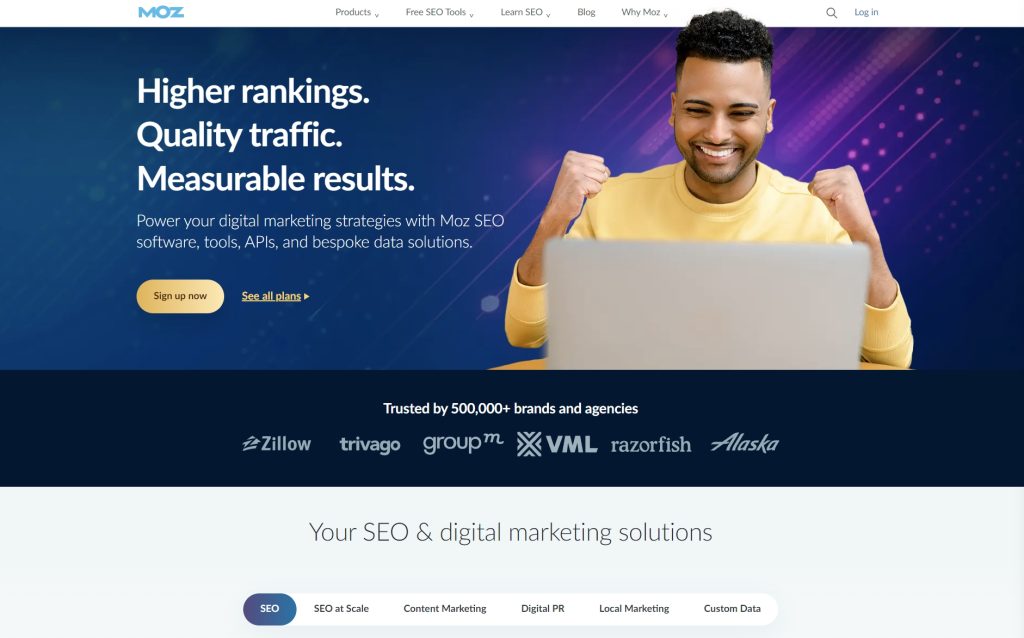
Comme les deux autres plateformes ici présentes, Moz fournit des outils de référencement essentiels tels que suivi des mots-clés, audits de siteset l'analyse des liens retour. Son extension de navigateur MozBar, unique en son genre, permet d'obtenir des informations sur le référencement en cours de route. De plus, les ressources de formation complètes de Moz et le soutien de la communauté sont particulièrement bénéfiques pour les PME qui cherchent à améliorer leurs connaissances et leurs compétences en matière de référencement.
Le Tableau de bord Moz Pro offre une vue d'ensemble claire de vos performances en matière de référencement, ce qui facilite le suivi de vos progrès. Grâce à des rapports détaillés, vous pouvez identifier les points à améliorer et prendre des mesures pour améliorer votre classement dans les moteurs de recherche.
En outre, L'explorateur de liens de Moz vous permet d'analyser votre profil de liens retour et d'identifier les opportunités de construction de liens de haute qualité. L'amélioration de votre profil de liens retour peut renforcer l'autorité de votre domaine et votre classement dans les moteurs de recherche.
Prix : Le plan Starter commence à $49 par mois et s'adresse aux PME et aux professionnels. Trois autres plans sont disponibles, le plan large ($299/mois) étant destiné aux grandes entreprises.
5. EmbedSocial - SEO Schema Codes et recherche de mots-clés pour les critiques
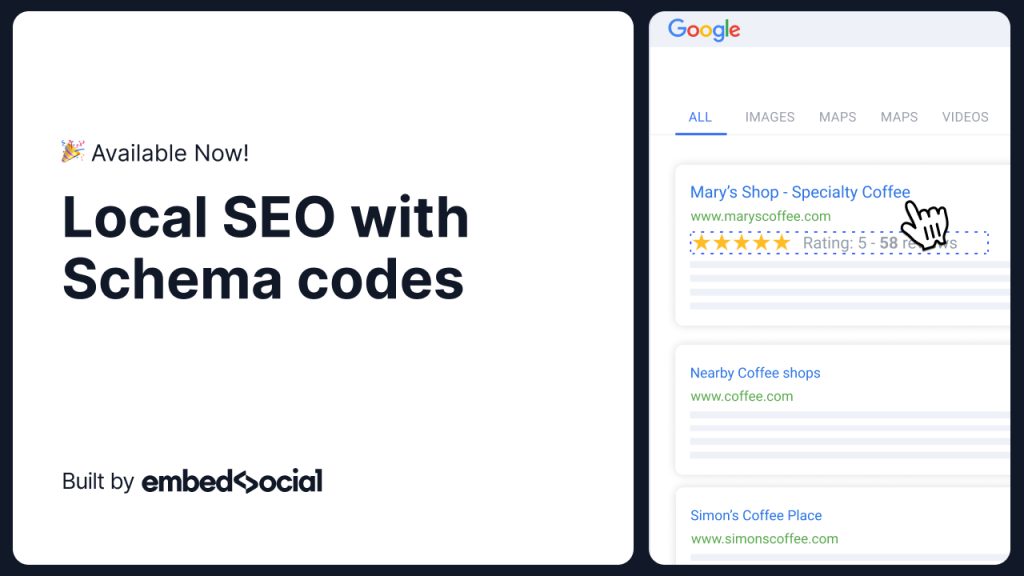
EmbedSocial est une vaste plateforme intégrée au système d'information de la Commission européenne. API de profil d'entreprise Google. Il permet aux utilisateurs de rassembler tous leurs avis Google, d'effectuer des recherches dans les avis Google, de les étiqueter et de les organiser pour une meilleure compréhension.
La plateforme offre deux fonctionnalités principales pour aider à améliorer les mesures de référencement local :
- Autorépondeur Google - Répondre par un autorépondeur à chaque avis Google afin d'augmenter le nombre d'avis. le temps de réponse moyen, ce qui a un impact direct sur le classement et améliore le référencement local.
- Code de schéma Google - EmbedSocial fournit un code de schéma ainsi qu'un code d'identification de l'utilisateur. Widget des avis de Google qui, lorsqu'ils sont intégrés ensemble sur la page d'un produit ou d'un service, affichent l'extrait vedette. Cet extrait a un impact direct sur la visibilité et, par conséquent, sur l'augmentation des taux de clics et du trafic vers votre site web.
D'autres indicateurs de référencement local sont proposés aux utilisateurs de la plateforme. Si vous avez besoin d'aide, n'hésitez pas à contacter l'équipe dans le chat en bas à droite du site web.
Conclusion : Augmentez vos efforts de référencement pour vous classer dans les moteurs de recherche !
En fin de compte, quels sont les indicateurs hebdomadaires de référencement que vous devez mesurer ? Vous devez suivre le classement des mots clés, le trafic organique et les taux de rebond et de clics.
Après tout, l'analyse des données et des indicateurs de référencement est importante si vous voulez vous assurer que vos efforts sont efficaces et qu'ils vous aideront à grimper dans les pages de résultats des moteurs de recherche.
Que vous soyez une petite ou une grande entreprise, le suivi du référencement est une activité que vous devez effectuer régulièrement pour développer votre marque, améliorer l'expérience des utilisateurs et maximiser le retour sur investissement.
Il n'y a rien de compliqué à cela ! Surtout si vous utilisez les outils ci-dessus, qui vous donnent souvent l'essentiel de ce dont vous avez besoin pour développer votre marque. Ensuite, une fois que vous serez sur la bonne voie, vous construirez une solide Profil d'entreprise Google en un rien de temps !
Pour ce faire, il convient d'examiner les meilleurs stratégies de gestion de la réputation en ligne que vous devez mettre en œuvre immédiatement, par exemple en vous inscrivant à un programme d'éducation à l'environnement. UGC avec une connexion directe à l'API de Google, telle que EmbedSocial!
FAQ
Que sont les indicateurs dans le domaine du référencement ?
Les indicateurs de référencement sont des mesures quantifiables utilisées pour suivre les performances et l'efficacité des efforts de référencement. Ces mesures fournissent des informations sur divers aspects, tels que le trafic, le classement des mots clés et l'engagement des utilisateurs, aidant ainsi les entreprises à comprendre l'efficacité de leurs stratégies de référencement.
Pourquoi les indicateurs de référencement sont-ils importants pour les entreprises ?
Les indicateurs de référencement sont essentiels pour les entreprises, car ils offrent des informations fondées sur des données quant à l'efficacité de leurs stratégies de référencement. En suivant ces indicateurs, les entreprises peuvent identifier les domaines à améliorer, prendre des décisions éclairées et, en fin de compte, améliorer leur visibilité en ligne, attirer plus de visiteurs et augmenter les conversions.
Quels sont les indicateurs clés de performance en matière de référencement ?
Les indicateurs clés de performance (ICP) en matière de référencement sont des mesures spécifiques qui reflètent le succès d'une campagne de référencement. Les indicateurs clés de performance les plus courants comprennent le trafic de recherche organique, le classement des mots clés, les taux de clics (CTR), les taux de rebond et les taux de conversion. Ces indicateurs aident les entreprises à mesurer les progrès accomplis dans la réalisation de leurs objectifs de référencement.
Quels sont les 4 facteurs de classement SEO ?
Les quatre principaux facteurs de classement SEO sont la qualité du contenu, les liens retour, le référencement technique et l'expérience utilisateur. La qualité du contenu implique la production d'un contenu pertinent et utile ; les liens retour renvoient à des liens provenant d'autres sites web ; le référencement technique inclut la vitesse du site et la convivialité pour les mobiles ; et l'expérience utilisateur se concentre sur des facteurs tels que la facilité d'utilisation du site et l'engagement.
À quelle fréquence dois-je suivre les indicateurs de référencement ?
Les indicateurs de référencement doivent être suivis régulièrement pour garantir une optimisation continue. Un suivi hebdomadaire est recommandé pour rester à l'affût des tendances et procéder à des ajustements en temps opportun, tandis qu'un examen mensuel plus complet peut aider à identifier des modèles à long terme et à mesurer l'efficacité globale des stratégies de référencement.
Quels sont les meilleurs outils pour suivre les indicateurs de référencement ?
Google Analytics, Ahrefs, SEMrush et Moz comptent parmi les meilleurs outils de suivi des mesures de référencement. Ces outils fournissent des données complètes sur divers aspects du référencement, tels que le classement des mots clés, les sources de trafic, les profils de liens retour et les audits de sites, ce qui permet aux entreprises de surveiller et d'améliorer plus facilement leurs performances en matière de référencement.
Comment puis-je améliorer mes indicateurs de référencement ?
L'amélioration des indicateurs de référencement passe par l'optimisation du contenu pour les mots clés pertinents, la création de liens retour de haute qualité, l'amélioration de l'expérience utilisateur en améliorant la vitesse du site et la convivialité pour les mobiles, et la mise à jour régulière du contenu pour qu'il reste frais et utile. En outre, l'utilisation d'outils de référencement pour identifier et résoudre les problèmes techniques peut considérablement améliorer vos performances en matière de référencement.
